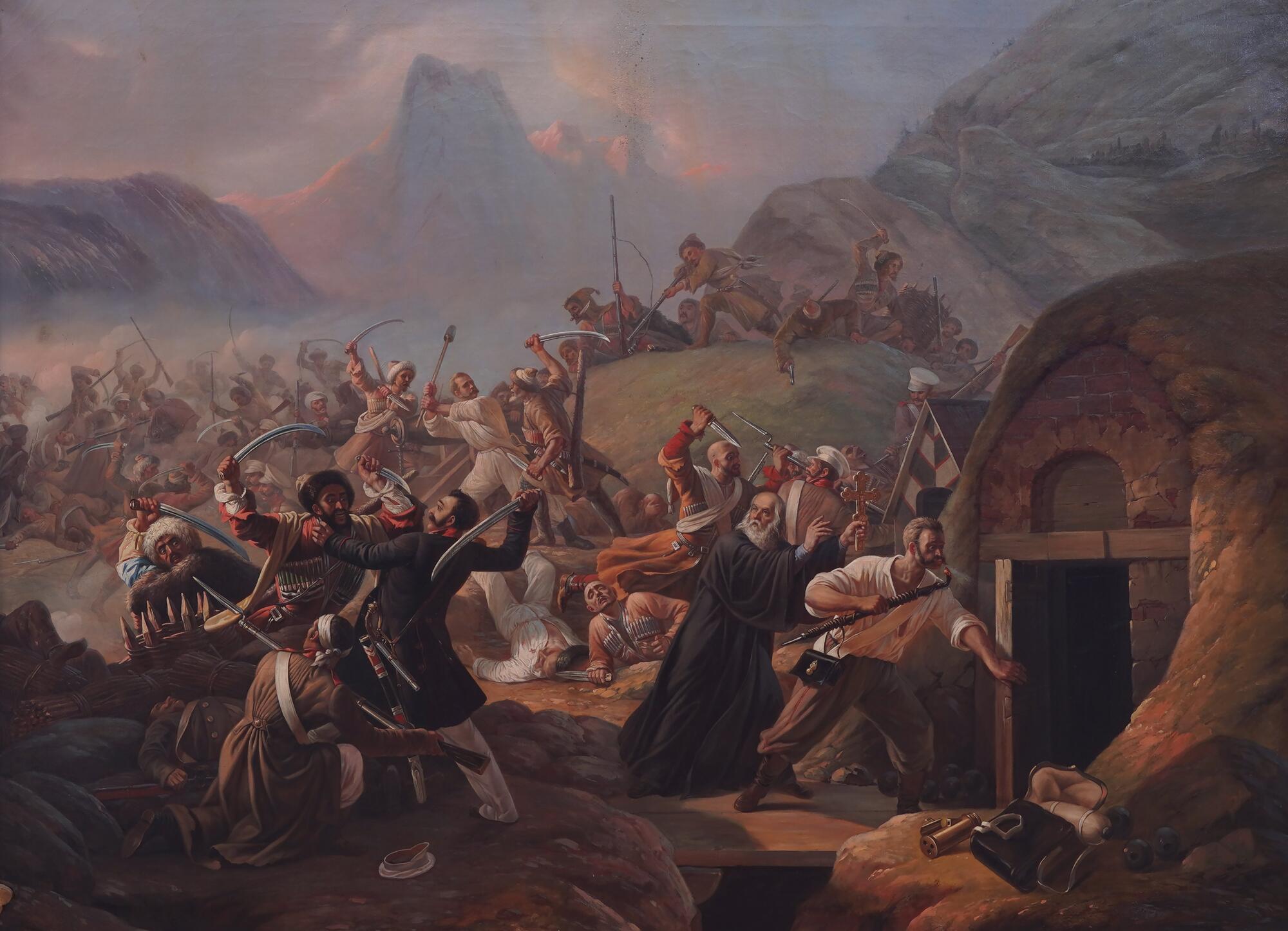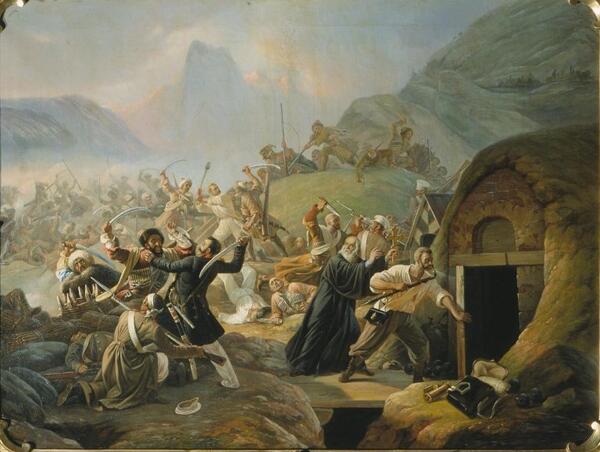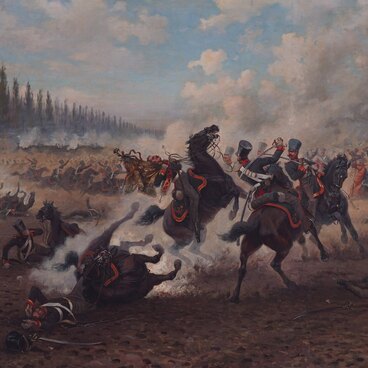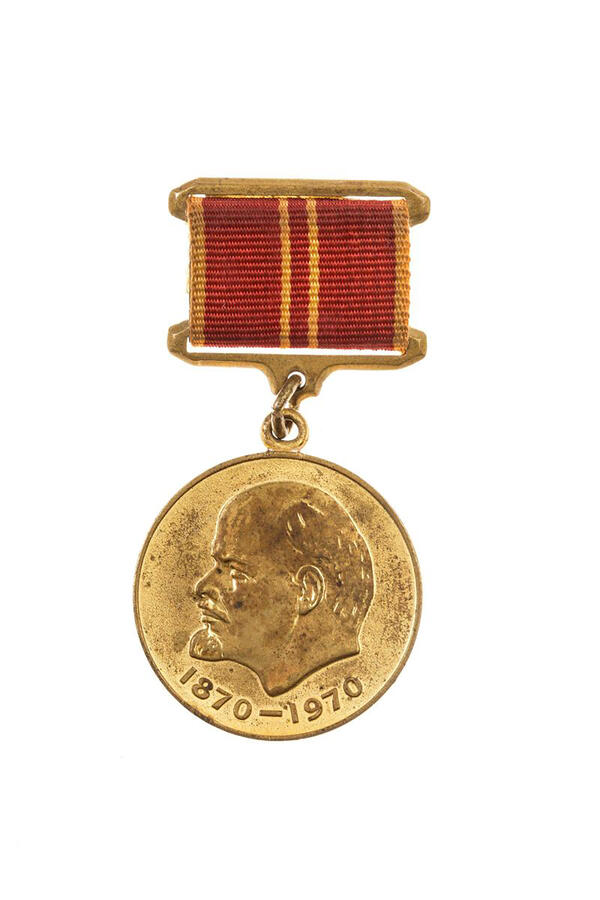The main character of the painting presented in the exhibition, Arkhip Arkhipovich Osipov, was a serf peasant and was accepted in the Crimean Infantry Regiment in 1820 as a private recruit. In his second year of service, he ran away, was tried and punished by being forced to run between rows of 1000 soldiers who stroke and attacked him with a stick, which was a popular form of corporal punishment at that time. However, in subsequent years he proved himself as an excellent soldier. He was awarded an honorary sleeve patch and silver medals.
In 1834, Osipov began serving in the Tenginsky Infantry Regiment under the command of Staff Captain Nikolay Konstantinovich Liko, who was known for his strictness and fairness, and was respected by the lower ranks.
On March 20, 1840, a unit of 11,000 highlanders broke into Mikhailovskoye, a fortification in the valley of the Vulan River. The breakthrough was preceded by a two-day bloody battle in which almost all the defenders of the fortification were killed.
The idea of blowing up a warehouse where gunpowder was stored belonged to private Osipov. After coordinating the operation with Liko, he took leave of his comrades and fulfilled his intention. Having ignited the gunpowder by using an artillery firing pin, he blew himself up along with the warehouse and the entire fortification. About 3,000 highlanders were killed by the explosion, the rest retreated. Seriously wounded, Nikolay Liko soon died in captivity among the highlanders from gangrene in his wounded leg.
The surviving comrades of Osipov conveyed to Nicholas I the last words of the hero, “It is time, brothers! Those who will stay alive — remember my deed!” The emperor fulfilled his last will. The name of the “first private” was inscribed in the lists of his unit. At roll calls, the next private on the list was obliged to report “for Osipov” and say, “He died for the glory of Russian weapons in the Mikhailovskoye fortification.” For the first time in the military history of Russia, a distinguished soldier posthumously remained in his unit forever.
In 1876, by order of the viceroy of Caucasus, Grand Duke Mikhail Nikolaevich, a cast-iron cross was erected on the site of the feat so that it could be seen from the ships passing by.
In 1889, the Cossack stanitsa of Vulanovskaya on the site of the former fortification was renamed Arkhipo-Osipovka.
Alexander Alekseevich Kozlov (1816–1884) who created the presented canvas was a painter and etcher. He depicted the main characters of his painting in profile to the viewer. This can be explained not only by the plot. As there were no portrait images of Private Arkhip Osipov and Staff Captain Liko, the artist relied on verbal descriptions to paint their faces.
In 1834, Osipov began serving in the Tenginsky Infantry Regiment under the command of Staff Captain Nikolay Konstantinovich Liko, who was known for his strictness and fairness, and was respected by the lower ranks.
On March 20, 1840, a unit of 11,000 highlanders broke into Mikhailovskoye, a fortification in the valley of the Vulan River. The breakthrough was preceded by a two-day bloody battle in which almost all the defenders of the fortification were killed.
The idea of blowing up a warehouse where gunpowder was stored belonged to private Osipov. After coordinating the operation with Liko, he took leave of his comrades and fulfilled his intention. Having ignited the gunpowder by using an artillery firing pin, he blew himself up along with the warehouse and the entire fortification. About 3,000 highlanders were killed by the explosion, the rest retreated. Seriously wounded, Nikolay Liko soon died in captivity among the highlanders from gangrene in his wounded leg.
The surviving comrades of Osipov conveyed to Nicholas I the last words of the hero, “It is time, brothers! Those who will stay alive — remember my deed!” The emperor fulfilled his last will. The name of the “first private” was inscribed in the lists of his unit. At roll calls, the next private on the list was obliged to report “for Osipov” and say, “He died for the glory of Russian weapons in the Mikhailovskoye fortification.” For the first time in the military history of Russia, a distinguished soldier posthumously remained in his unit forever.
In 1876, by order of the viceroy of Caucasus, Grand Duke Mikhail Nikolaevich, a cast-iron cross was erected on the site of the feat so that it could be seen from the ships passing by.
In 1889, the Cossack stanitsa of Vulanovskaya on the site of the former fortification was renamed Arkhipo-Osipovka.
Alexander Alekseevich Kozlov (1816–1884) who created the presented canvas was a painter and etcher. He depicted the main characters of his painting in profile to the viewer. This can be explained not only by the plot. As there were no portrait images of Private Arkhip Osipov and Staff Captain Liko, the artist relied on verbal descriptions to paint their faces.




